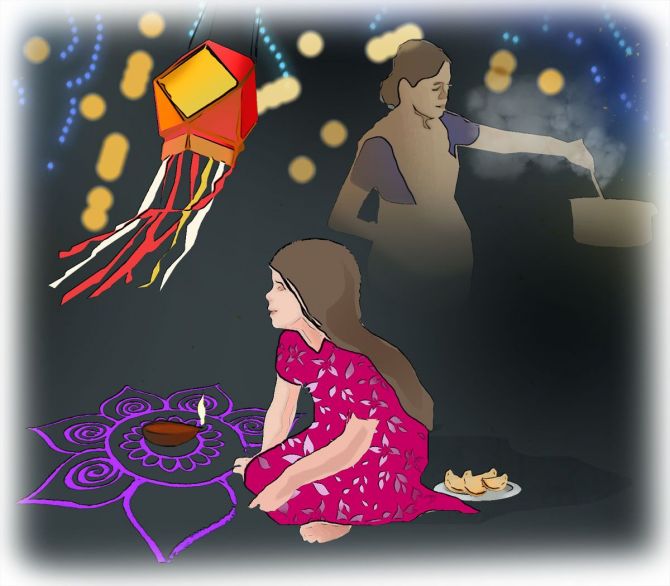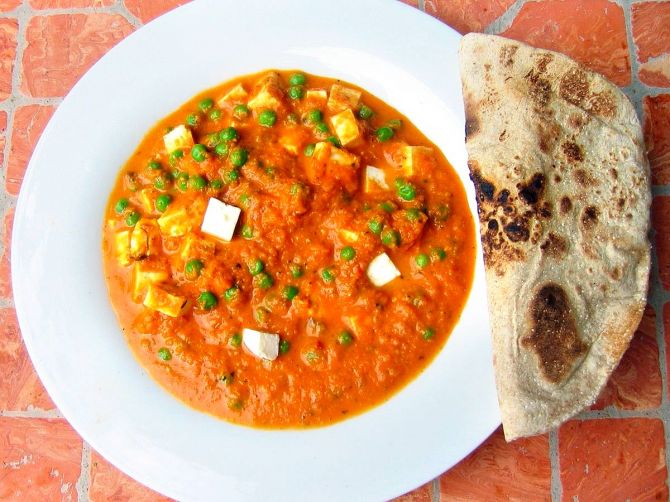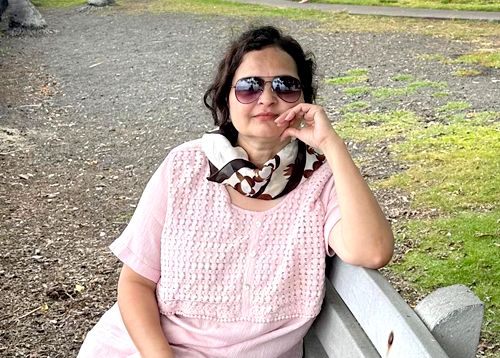My childhood memories from Sitapur, Uttar Pradesh, are full of nostalgia. But there is nothing more nostalgic than memories of our Diwalis in this little town.
I would say those memories are therapeutic, for me, at least.
Diwali is not just about a day. It's a series of five days. Each day holds its own significance. A different deity is worshipped on each day and there is a story behind each.

I can recall lots of planning, shopping, cleaning, preparations and the making of pakwan (Diwali treats). The whole house would waft with the aromas of delicious sweets and savouries.
Each one of us was given a task to assist our elders in cleaning or with pakwan-making. But at that time, it was not considered as a boring task for us. Rather it was an activity done together with all the cousins and full of excitement and masti (fun).
Dhanteras
When we were young, the excitement began with the planning of the trips to the bazaar with our grandparents to buy Ganesh and Lakshmi murtis made of mud only. Looking at the various idols, colours, the creativity of simple village artisans, and then, with much research, finally choosing which ones to bring home, or rather, now I would say, which one chooses you and to come to your home to bless you.
Roaming in a fully crowded bazaar, where no vehicles were allowed on Dhanteras, you met so many of your old friends. That was a maja in itself -- growing up in a small town with only one market had its own charm.
Usually people buy metals, silver, gold etc for Dhanteras and put it in the puja ghar (home temple) for good luck. But now one realises the larger meaning is to balance various elements in our body and in our surroundings to keep ourselves healthy.
Chhota Diwali or Narkachaudas
This day focuses on cleaning or cleansing. I distinctly remember my grandmother calling us in the morning and giving each of us an earthen pot full of water, which had been kept under the stars for the full night, to bathe with.
Diwali
It was the day of puja of Shri Lakshmi and Ganesh.
After the puja, the main agenda and fun was lighting the crackers. But before this, we had to dress up well and decorate the whole house with diyas and flowers. Simple bandhanwar (main door decoration) were made from flowers and ashoka tree leaves.
The celebrations didn't stop there. After that playing cards with all the cousins was an excitement of another level -- gossiping, chatting, cracking jokes, munching on gujjiyas, matharis and hot tea in the night would be so much fun.
No ordering food from outside or watching your personal shows on mobiles -- those were the days and late nights of get-togethers for bonding amongst cousins, relatives and friends.
Govardhan Puja or Annakoot
According to legend, Lord Krishna saved the people of Gokul from Lord Indra. On this day Lord Krishna is offered food of various varieties -- to be precise 56 food items. A large variety of food was cooked in big vessels and kept in the puja ghar as an offering.
After the puja and bhog, we would eat the meal sitting on the floor in pattals (leaf plates) with a houseful of relatives, friends and extended family.
Simple food, sufficient enough for all, served and consumed with love and gratitude. Aloo Bhaji, puris, rice, saffron rice and the main highlight was the mixed vegetable, which included all the vegetables, leafy or root, veg available in the market during that season.
Celebration of the bond between brothers and sisters
Then came Bhaidooj, on the fifth and last day, and the earnings of the sisters during childhood (now can laugh about it). Negotiations and demands among brothers, sisters, cousins started much before.
Afterwards we all hogged on hot puris and Khoya Makhana Sabji.
The Khoya Makhana Sabji was delicious. Have a go at making it with my recipe.

Khoya Makhana Sabji
Serves: 2-3
Ingredients
- 1 tsp ghee
- 2-3 lavang or cloves
- 1 green elaichi or cardamom
- ½ bada elaichi or black cardamom
- 2-3 tej pattas or bay leaves
- 1 cup makhana or fox nuts
- 1 cup boiled peas
- 2-3 tomatoes, pureed
- ½ cup khoya or milk solids
- ½ cup small cubes paneer, optional
- 1 tsp sugar
- Few pinches kasuri methi or dried fenugreek leaves
Method
- In a saucepan or kadhai, saute the cloves, the two types of cardamom, bay leaves in the ghee over medium heat.
Add the makhana.
Add the tomato puree.
Cook for 3-4 minutes.
Add in the khoya.
Saute till pink.
Add the peas, paneer, sugar.
Bring to a boil for 3-4 minutes over low heat.
Add the kasuri methi. - Serve with hot puris.

Deepa Mehrotra hails from Sitapur, Uttar Pradesh, but has been living in Mumbai for over two decades. In the family, she is famous for her recipe repertoire, especially a unique carrots and beans paneer dish. And her Chole Bhatura and a super Jackfruit Pulau.











